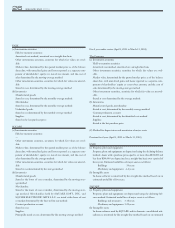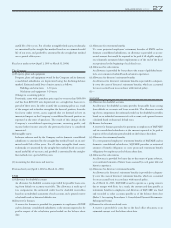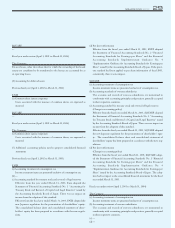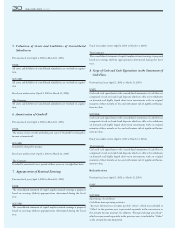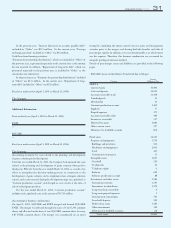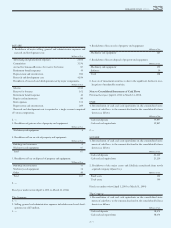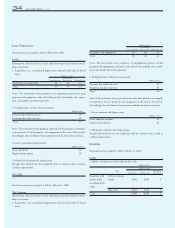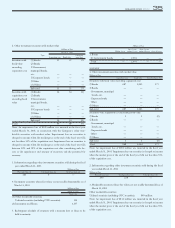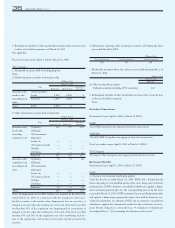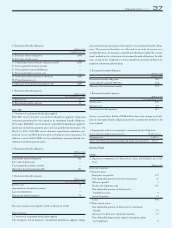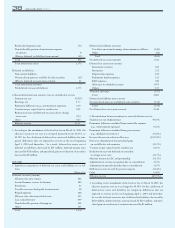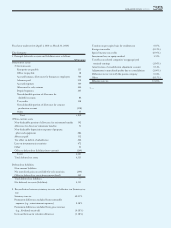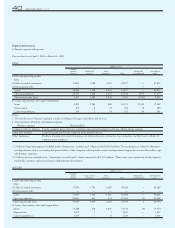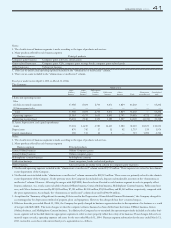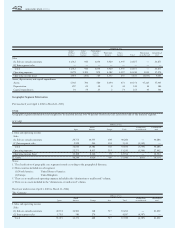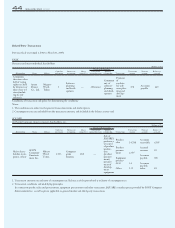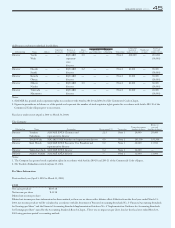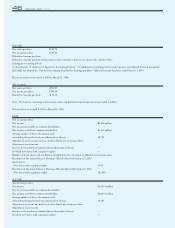Square Enix 2004 Annual Report Download - page 38
Download and view the complete annual report
Please find page 38 of the 2004 Square Enix annual report below. You can navigate through the pages in the report by either clicking on the pages listed below, or by using the keyword search tool below to find specific information within the annual report.
36 SQUARE ENIX 2004
4. Redemption schedule of other marketable securities with a maturity date
or those to be held to maturity as of March 31, 2003
Not applicable
Fiscal year under review (April 1, 2003 to March 31, 2004)
The Company
1. Marketable securities held for trading purposes
None
2. Held-to-maturity securities with market value
Millions of Yen
March 31, 2004
Type Unrealized
Book value Market value gain (loss)
Securities with (1) Government
market value bonds 2,000 2,000 0
exceeding book Sub-total 2,000 2,000 0
value
Total 2,000 2,000 0
3. Other investment securities with market value
Millions of Yen
March 31, 2003
Type Unrealized
Acquisition cost Book value gain (loss)
Securities with (1) Stocks 179 797 617
book value (2) Bonds
exceeding ①Government,
acquisition cost municipal
bonds, etc. — — —
②Corporate bonds — — —
③Other — — —
(3) Others — — —
Sub-total 179 797 617
Securities with (1) Stocks 76 71 (4)
acquisition cost (2) Bonds
exceeding book ①Government,
value municipal
bonds, etc. — — —
②Corporate bonds — — —
③Other — — —
(3) Others — — —
Sub-total 76 71 (4)
Total 256 869 613
Note: An impairment loss of ¥222 million was incurred in the fiscal year
ended March 31, 2004, in connection with the Company’s other mar-
ketable securities with market value. Impairment loss on securities is
charged to income when the market price at the end of the fiscal year falls
not less than 50% of the acquisition cost. Impairment loss on securities is
charged to income when the market price at the end of the fiscal year falls
between 30% and 50% of the acquisition cost after considering such fac-
tors as the significance and amount of securities and the potential for
recovery.
4. Information regarding other investment securities sold during the fiscal
year ended March31, 2004
Millions of Yen
Proceeds from sale Total gain from sale Total loss from sale
156 59 84
5. Marketable securities whose fair values are not readily determinable as of
March 31, 2004
Millions of Yen
March 31, 2004
Book value
(1) Other marketable securities
Unlisted securities (excluding OTC securities) 165
6. Redemption schedule of other marketable securities with a maturity date
or those to be held to maturity
None
Derivative Transactions
Previous fiscal year (April 1, 2002 to March 31, 2003)
ENIX
The ENIX Group does not engage in derivative transactions.
SQUARE
The SQUARE Group does not engage in derivative transactions.
Fiscal year under review (April 1, 2003 to March 31, 2004)
The Company
The Square Enix Group does not engage in derivative transactions.
Retirement Benefits
Previous fiscal year (April 1, 2002 to March 31, 2003)
ENIX
1. Overview of retirement benefit plan applied
Until the fiscal year ended March 31, 2002, ENIX had a defined benefit
plan comprising of a tax qualified pension plan and a lump-sum retirement
payment plan. ENIX’s domestic consolidated subsidiaries applied a lump-
sum retirement payment plan for the corresponding period. In the fiscal
year ended March 31, 2003, ENIX terminated its tax qualified pension plan
and applied a lump-sum payment plan only in line with its domestic con-
solidated subsidiaries. In addition, ENIX and its domestic consolidated
subsidiaries applied the conventional method in the calculation of retire-
ment benefit obligation as described in, “4. Summary of Significant
Accouting Policies”, “(3) Accounting for allowances and reserves”.


